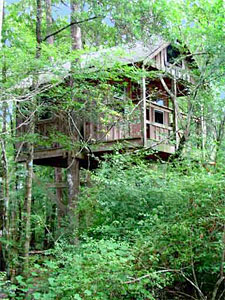
Put a house in your tree
Winston Churchill and John Lennon had one. Mohammad Al Fayed, David Beckham and the Duchess of Northumberland have one. So do Jonathan Ross and David Attenborough. Now Chelsea footballer John Terry and TV presenter Eamonn Holmes want one.
We’re talking tree-houses, the new way of returning to your childhood. And they’re not being built just for the kids any more. Grown-ups are taking to them, too, in a bid to wind down from their increasingly stressful lives. Peter Nelson’s Seattle-based company TreeHouse Workshop has built more than 60 treehouses in the last six years, many of them for adults. The world’s largest treehouse builder, Scotland-based TreeHouse Co., fields “far more enquiries from the States than from all other countries combined,” says president John Harris, whose company will build more than 150 treehouses this year, up from 40 in 2000 and three in 1996.
In the past five years, home offices, libraries, guest rooms, even entire houses have increasingly begun migrating skyward, aided by a tightknit cadre of treehouse architects, carpenters, arborists and engineers who build treehouses full time.
Tree-houses are the ultimate in bespoke construction. Commercially, prices range from a simple raised deck at 500 to a staggering 3.3m, which was how much the Duchess of Northumberland forked out for her tree-house palace in the grounds of Alnwick Castle – the world’s largest. It measures 2,500 sq ft, nestles in a copse 50ft above ground, and took a year to build.
 The Treehouse Book – BUY IT on Amazon US
The Treehouse Book – BUY IT on Amazon US
The Treehouse Book on Amazon UK
People opt for their wooden getaway in the sky for all sorts of reasons. The most obvious is that it’s a place for the children and their friends to have a place they can call their own. Tree-house builder Belinda Ogle, founder of Live Life Outdoors, made one for her two children, who demanded a trap door and entrance via rope, to keep all adults out. Since completion, she has not been allowed to set foot inside.
But the range of facilities that tree-houses can now accommodate is stunning. There are drinks decks, dining rooms, dance floors, kitchens with Agas, bathrooms with hot and cold running water, toilets, gazebos, showers, whirlpool baths, sleepover bedrooms, spiral staircases, recording studios, music centres and TV lounges. A private school in Salisbury had a classroom built in an old tree for lessons in art and the environment, and a 32- seater restaurant in the South-west has given haute cuisine a new meaning.
With concern about the time that children spend lolling around playing computer games and the resultant rise in obesity levels, outdoor activity is seen as a counterbalance. The sight of her inactive children slumped watching television was the spur for Ogle to set up her tree-house construction company.
Tree-houses come with a good pedigree. Treehouse living reaches back to ancient times, says Harris, a self-appointed historian of the treehouse movement who enjoys putting this “treehouse revival” in context. Long ago, “humans used to live in trees,” he says. “It was the most hygienic way to live.” Eventually people descended, but throughout history they have built in the boughs again and again. In 16th and 17th century Europe, for instance, “any well-to-do person had a treehouse,” he says. “They were the places that the landed gentry took their girlfriends.” The Roman emperor Caligula held banquets in his, and the Medici family in Italy vied to see who could build the grandest. They were all the rage in Tudor times. The oldest extant one in the UK is at Pitchford Hall, near Shrewsbury, whose origins date to the 16th century.
In today’s environmentally conscious climate, it seems some of us are rediscovering the delights of living, at least for a few hours at a time, with our heads in the clouds. Writers in need of peace and quiet may prefer a tree-house to a garret. And tree-houses invariably enhance the value of your property. The best trees to build on are neither too old nor too young. The favourite species are oak, ash, chestnut, lime, pine, beech, apple, walnut, pear and fir. Avoid elm, sycamore or silver birch. The favourite wood for the actual construction is cedar or pine. Planning permission is required when an adjoining property will be overlooked.
John Harris’s clients have requested tree-houses that replicate the design of their main home – circular in one case – one that looks like their boathouse, and even a remake of the Ewok house in Star Wars.
But be warned! “One grouch can take all the wonderment and fantasy away,” says Jeri Chiavetta, a Huntington Beach grandmother who in 2000 was forced to remove her Greene and Greene-style treehouse after a neighbor complained. Few cities have specific treehouse zoning regulations, so negative attention can be a death knell. Locals rallied with petitions and “Save the Treehouse!” signs, to no avail. Greenwood, the engineer, is working on a model treehouse code that may someday, he hopes, be adopted by city governments.
Until then, make friends with neighbors. Invite them skyward. Once people leave the ground, say treehouse owners, they are more likely to build their own hideaway than to nix yours.
Belinda Ogle, Live Life Outdoors, 01306 885886 or 07843 282104, www.livelifeoutdoors.co.uk.
John Harris, TreeHouse Company, 01560 600111, www.treehouse-company.com.